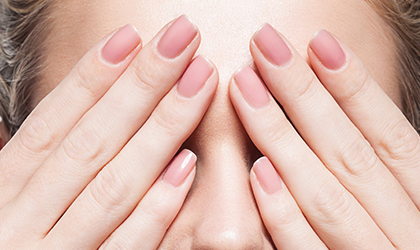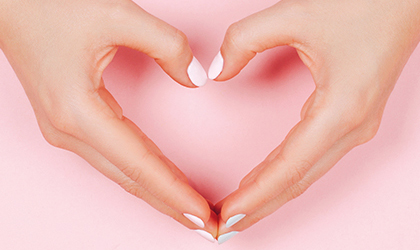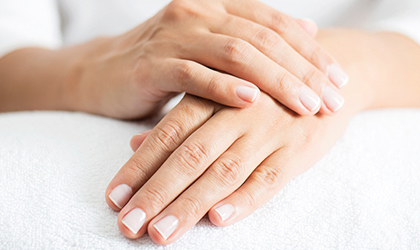Whether you paint yours or leave them to remain natural, nails whether on your fingers or your toes serve an important purpose. First, they protect the tips of your fingers and toes. And at least where fingernails are concerned, they may also improve your fingertips’ sense of touch.
There are several components that make up your nails, namely the root, the nail bed, the nail plate, the eponychium, perionychium and hyponychium.
The nail root is under the skin behind the fingernail and extends several millimetres into the nail bed (the edge of the root is the visible white crescent shape often called a half moon the medical term for this structure is the lunula).
Nail bed
This extends from the lunula to the hyponychium (the edge of the nail where it’s still attached to the skin of the fingertip – see below). The nail bed contains blood vessels, nerves and melanin-producing cells called melanocytes.
Nail plate
This is the actual nail itself, which is made of a substance called keratin. The pink colour under the nails is produced by the nail bed’s blood vessels.
Eponychium
Often confused with the cuticle, the eponychium is made up of living tissue found at the edge of the skin where it meets the start of the nail plate. It forms a seal to protect the new nail plate as it grows. The cuticle, on the other hand, is a thin layer of dead tissue that also forms a seal, but this time between the nail plate and the eponychium.
Perionychium
If you’ve ever had a hangnail or an ingrown nail, it arises from the perioncyhium (this is the skin on the sides of the nail plate).
Hyponychium
This is where the far edge of the nail plate and the skin of the fingertip meet.
Nail facts: did you know?
Fingernails grow faster than toenails (they grow at an average rate of 3mm per month compared to the average growth of toenails at 1mm per month) (i). It takes about six months for a fingernail to grow from the root to the free edge (the part of the nail that extends from the edge of the nail bed). But toenails take a year or more to fully regenerate. However, as you get older, your nails grow more slowly and can become more brittle.
Common nail problems
There are many different types of problems that may affect your nails. Here’s a quick guide to the most common ones and what they say about your health:
Thickened nails
Often these can be a sign of a fungal nail infection, though they can also be caused by psoriasis, a form of arthritis called reactive arthritis, and wearing badly fitting shoes for a long period of time.
Brittle or weak, crumbling nails
These can also be a sign of a fungal nail infection, but often they are a result of exposure to water, detergents and other chemicals such as those found in nail polish. Other conditions that cause brittle, crumbly nails include an underactive or overactive thyroid, nail psoriasis and a skin condition called lichen planus.
Discoloured nails
Nails can turn grey, brown or green-black, but possibly the most common discolouration of nails is yellowing. Again, fungal nail infections and nail psoriasis can be behind this common nail problem. Other things that could cause yellow-coloured nails include sinusitis, jaundice (which turns the skin under the nail plate yellow), tuberculosis, lymphoedema (which causes swelling of the skin) and infection of the nail folds (or perionychium).
Using nail polish for extended periods of time can also discolour your natural nails. Nails that are half white and half brown, on the other hand, may be a sign that your kidneys aren’t working properly.
Nail dents
Pitting or small dents on the surface of the nails can be a sign of psoriasis (according to the NHS, up to 50 per cent of people with psoriasis have pitted nails (ii)). This can also be caused by eczema, reactive arthritis and a type of hair loss called alopecia areata.
Curved nails
This is when there’s a spoon-shaped dent in your nails, which is also known as koilonychia. There are a few reasons why you may have these inward curves in your nails, including iron-deficiency anaemia (plus the opposite of iron-deficiency anaemia, called haemochromatosis, where you have too much iron in your system), Raynaud’s disease and lupus.
Nail ridges
Vertical ridges on your nails often become more prominent as you get older but are rarely anything to worry about. Sometimes, however, they can be a sign that you are lacking in iron, folic acid or protein. But if you have grooves that run horizontally across your nails, the effect is called Beau’s lines, and it may be caused by a previous illness or injury, chemotherapy or if you have Raynaud’s disease by previous exposure to very cold temperatures (the ridges will appear several months after exposure).
Loose nails
Injuries to nails can lead to them becoming loose and eventually falling off. But if you haven’t sustained an injury it’s possible that a loose nail could be caused by a fungal nail infection, nail psoriasis, poor circulation, an overactive thyroid or a serious condition called amyloidosis, which is the result of proteins building up in tissues and organs in your body.
White horizontal lines
If you have white lines that run in parallel across your nails, it may be a sign that you have low protein levels, possibly because you have liver disease. White spots or specks under the nails are less of a worry, with some experts believing they may be a sign of zinc deficiency (iii).
For more information on some other common foot problems, see our in-depth guide.
Treatments for fungal nail infections
A fungal nail infection is one of the most common things that affects the appearance of the nails, causing discolouration, thickening, brittleness and crumbling. It can affect your fingernails or your toenails, and if left untreated it can lead to pain and discomfort (though for most people, the changed appearance of the nail is the main issue). The infection can also spread to your other nails if you don’t take steps to deal with it.
Fungal infections of the toenails is often caused by the athlete’s foot, a fungal skin infection that can easily spread from between the toes to the nails. Certain health problems may also make you more susceptible to developing a fungal nail infection, including diabetes and psoriasis.
How is it treated?
Keeping your nails clean and cool ? especially your toenails ? can help to treat and prevent fungal nail infections. However, if you have a more severe infection you may need to take antifungal medicines, which are available as prescription tablets, or over-the-counter liquids that you paint on the affected nail.
The advantage of antifungal tablets is that they tend to work more quickly than nail paints. However, they can cause unpleasant side effects, including headache, nausea and diarrhoea. Antifungal nail paints, on the other hand, may have to be applied for up to a year (in the case of a toenail). There are also products you can buy that soften and remove the fungus along with the affected part of the nail plate.
If these antifungal medicines aren’t effective, your GP may recommend that you have surgery to remove the infected nail. A new nail usually grows in its place though it could take a year or more. Laser treatment may also be used to treat fungal nail infections effectively (though this can work out expensive).
How to keep your nails healthy
Living a healthy lifestyle may help keep your nails strong and attractive. Here are some of the things you should do to keep your fingers – and toes – in great shape:
-
Moisturise your nails frequently at least once a day by using good-quality hand cream or a nail and cuticle oil.
-
Try not to bite your nails or pick your cuticles, both of which may damage the nail bed as well as cause infections. Similarly, if you have a hangnail, don’t bite it off, but carefully cut it off using proper nail clippers.
-
Keep your nails as dry and clean as possible. Where your toenails are concerned, help keep them cool and dry by letting your feet breathe as often as you can and avoiding wearing shoes and socks that make them feel hot and damp.
-
Keep fingernails strong by wearing gloves to reduce their exposure to water and chemicals.
-
A healthy diet can also help keep your nails healthy. Aim to include at least five portions of fruit and vegetables in your diet every day, plus make sure you’re eating enough iron, as too little can make your nails thin and misshapen. For more iron, eat plenty of liver, mussels, oysters, turkey, chicken and sardines (if you’re a vegetarian, go for iron-rich plant foods such as green leafy vegetables, lentils and beans). Eating the right amount of protein (fish, eggs, nuts, soya, dairy foods, chicken and turkey) may also help keep your nails strong.
-
If you have an ingrown toenail, don’t attempt to tackle it yourself ? you may well make the problem worse. Instead, see your GP or find a podiatrist who could help.
-
If you wear a lot of nail polish, give your nails the chance to breathe regularly by letting them go natural. Also avoid using nail polish removers that contain harsh chemicals such as acetone and formaldehyde.
-
Give yourself a weekly manicure and pedicure to make sure your fingernails and toenails are in the best possible condition.
-
During cold weather, make sure your feet and hands are warm when you’re outdoors, as cold temperatures can make your nails dry. Meanwhile, during the summer months, protect your nails from the sun by applying a sunscreen with sun protection factor (SPF) 15 or higher all over your hands and feet.
Natural supplements for nail health
Nail problems are surprisingly common, with about 20 per cent of people thought to be affected by brittle nails alone (iv). Thankfully there are a few nutritional supplements that may help, including the following:
Collagen
Our collagen supplement, Collagen Beauty, utilises the patented VERISOL® bioactive collagen peptides, with type I and III peptide profiles. Type I collagen is primarily found in hair, skin, and nails, while type III collagen is found in arteries, muscles, and connective tissue. This unique formulation provides hydrolysed collagen for improved absorption. This is because it has undergone enzymatic hydrolysis, a process that breaks down the peptides into shorter, more easily absorbed protein chains.
Clinical studies using VERISOL® bioactive collagen peptides have demonstrated that taking 2.5g of VERISOL® bioactive collagen daily over a period of 24 weeks significantly improved nail appearance. The studies found a 12% increase in nail growth, a 42% decrease in the frequency of broken nails, and 62% of participants noticed an improvement in brittle nails. 2.5g of VERISOL® Bioactive Collagen Peptides® is obtainable when taking 3 Collagen Beauty tablets per day.
We have also chosen to include additional nutrients such as biotin for the maintenance of normal hair, skin, and nails. Evidence suggests that biotin may especially be useful in terms of supporting nail strength and development. Read more about biotin below. While vitamin C promotes normal collagen formation and protection of cells from oxidative stress. Silica which is an essential building block and structural component of collagen, has also been included in Collagen Beauty and is one of the major nutrients used in the structural tissues, such as the nails.
Biotin
This B vitamin if widely recommended as a supplement for those with weak, brittle nails, with one study suggesting it may help increase the thickness of nails and make them less likely to split (v). Other studies also report improvements in nail health after taking biotin supplements (iv). Nutrition experts also advise combining B vitamins with vitamins C and E, as they are believed to work together to build keratin in the body as well as other proteins.
Zinc
White spots under the nails may be a sign of a mild zinc deficiency (vi). The good news is this can be easily rectified by taking a good-quality zinc supplement, or better still a high-strength multivitamin and mineral containing zinc, which may also boost your health in general. However, bear in mind that it may take several weeks before you may notice any difference in the appearance of your nails.
Iron
Iron is essential for maintaining healthy skin, hair and nails. This may explain why many experts believe ridges on the nails or nails that are weak and brittle may signify your body needs more iron (viii). This too can be obtained from a good-quality high-strength multivitamin and mineral supplement.
Fish oils
Salmon, herring, trout and other oily fish contain healthy omega-3 fatty acids, and experts believe a lack of omega-3s could contribute to brittle and dry nails (ix). If you don’t like eating fish, you can get omega-3s from a good-quality fish oil supplement. Meanwhile if you’re a vegetarian or vegan you can still benefit from an omega-3 supplement, thanks to the availability of products that contain the natural triglyceride (TG) form of omega-3. This is sourced from plant organisms called microalgae rather than fish.
References:
-
Evidence-Based Dermatology. Edited by Michael Bigby, Andrew Herxheimer, Luigi Naldi, Berthold Rzany, Robert Dellavalle, Yuping Ran, Masutaka Furue. Wiley-Blackwell. ISBN: 978-1-118-35767-5. Available online: https://www.wiley.com/en-gb/Evidence+Based+Dermatology%2C+3rd+Edition-p-9781118357675
-
Available online: https://www.nhsinform.scot/illnesses-and-conditions/skin-hair-and-nails/psoriasis#symptoms-of-psoriasis
-
Available online: https://www.healthline.com/health/white-spots-on-nails#causes
-
Andrews’ Diseases of the Skin by William James, Dirk Elston, James Treat, Mischa Rosenbach and Isaac Neuhaus. Elsevier 2019. Available online: https://www.elsevier.com/books/andrews-diseases-of-the-skin/james/978-0-323-54753-6
-
Colombo. VE, Gerber. F, Bronhofer. M , et al. Treatment of brittle fingernails and onychoschizia with biotin: scanning electron microscopy. J Am Acad Dermatol. 1990;23:1127-1132. Available online: https://pubmed.ncbi.nlm.nih.gov/2273113/
-
Floersheim. GL. Treatment of brittle finger nails with biotin. Z Hautkr. 1989;64:41-48. Available online: https://pubmed.ncbi.nlm.nih.gov/2648686/
-
Hochman. LG, Scher. RK, Meyerson. MS. Brittle nails: response to daily biotin supplementation. Cutis. 1993;51:303-305. Available online: https://pubmed.ncbi.nlm.nih.gov/8477615/
-
Pfeiffer. CC., Jenney EH., Fingernail White Spots: Possible Zinc Deficiency. JAMA. 1974;228(2):157. Available online: https://jamanetwork.com/journals/jama/article-abstract/353653
-
Singal. A., Arora R., Nail as a window of systemic diseases. Indian Dermatol Online J. 2015 Mar-Apr;6(2):67-74. Available online: https://www.ncbi.nlm.nih.gov/pmc/articles/PMC4375768/
Related Posts
Disclaimer: The information presented by Nature's Best is for informational purposes only. It is based on scientific studies (human, animal, or in vitro), clinical experience, or traditional usage as cited in each article. The results reported may not necessarily occur in all individuals. Self-treatment is not recommended for life-threatening conditions that require medical treatment under a doctor's care. For many of the conditions discussed, treatment with prescription or over the counter medication is also available. Consult your doctor, practitioner, and/or pharmacist for any health problem and before using any supplements or before making any changes in prescribed medications.

Christine
Christine Morgan has been a freelance health and wellbeing journalist for almost 20 years, having written for numerous publications including the Daily Mirror, S Magazine, Top Sante, Healthy, Woman & Home, Zest, Allergy, Healthy Times and Pregnancy & Birth; she has also edited several titles such as Women’ Health, Shine’s Real Health & Beauty and All About Health.
View More



